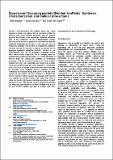Por favor, use este identificador para citar o enlazar a este item:
http://hdl.handle.net/10261/202797COMPARTIR / EXPORTAR:
 SHARE SHARE
 CORE
BASE CORE
BASE
|
|
| Visualizar otros formatos: MARC | Dublin Core | RDF | ORE | MODS | METS | DIDL | DATACITE | |

| Título: | Biopolymer/Glycopolypeptide-Blended Scaffolds: Synthesis, Characterization and Cellular Interactions |
Autor: | Dhaware, Vinita; Díaz Díaz, David CSIC ORCID ; Sen Gupta, Sayem | Palabras clave: | Adhesion Aggregates Cellular infiltration Spheroids |
Fecha de publicación: | 13-dic-2019 | Editor: | Wiley-VCH | Citación: | Chemistry - An Asian Journal 14(24): 4837-4846 (2019) | Resumen: | Three-dimensional (3D) scaffolds formed from natural biopolymers gelatin and chitosan that are chemically modified by galactose have shown improved hepatocyte adhesion, spheroid geometry and functions of the hepatocytes. Galactose specifically binds to the hepatocytes via the asialoglycoprotein receptor (ASGPR) and an increase in galactose density further improves the hepatocyte proliferation and functions. In this work, we aimed to increase the galactose density within the biopolymeric scaffold by physically blending the biopolymers chitosan and gelatin with an amphiphlic β-galactose polypeptide (PPO-GP). PPO-GP, is a di-block copolymer with PPO and β-galactose polypeptide, exhibits lower critical solution temperature and is entrapped within the scaffold through hydrophobic interactions. The uniform distribution of PPO-GP within the scaffold was confirmed by fluorescence microscopy. SEM and mechanical testing of the hybrid scaffolds indicated pore size, inter connectivity and compression modulus similar to the scaffolds made from 100 % biopolymer. The presence of the PPO-GP on the surface of the scaffold was tested monitoring the interaction of an analogous mannose containing PPO-GP scaffold and the mannose binding lectin Con-A. In vitro cell culture experiments with HepG2 cells were performed on GLN-GP and CTS-GP and their cellular response was compared with GLN and CTS scaffolds for a period of seven days. Within three days of culture the Hep G2 cells formed multicellular spheroids on GLN-GP and CTS-GP more efficiently than on the GLN and CTS scaffolds. The multicellular spheroids were also found to infiltrate more in GLN-GP and CTS-GP scaffolds and able to maintain their round morphology as observed by live/dead and SEM imaging. | Versión del editor: | https://doi.org/10.1002/asia.201901227 | URI: | http://hdl.handle.net/10261/202797 | DOI: | 10.1002/asia.201901227 | Identificadores: | doi: 10.1002/asia.201901227 e-issn: 1861-471X issn: 1861-4728 |
| Aparece en las colecciones: | (IPNA) Artículos |
Ficheros en este ítem:
| Fichero | Descripción | Tamaño | Formato | |
|---|---|---|---|---|
| Bipolymer_DDiaz_ChemAsian19.pdf | 4,49 MB | Adobe PDF |  Visualizar/Abrir |
CORE Recommender
SCOPUSTM
Citations
5
checked on 08-abr-2024
WEB OF SCIENCETM
Citations
5
checked on 24-feb-2024
Page view(s)
169
checked on 01-may-2024
Download(s)
237
checked on 01-may-2024
Google ScholarTM
Check
Altmetric
Altmetric
Este item está licenciado bajo una Licencia Creative Commons

